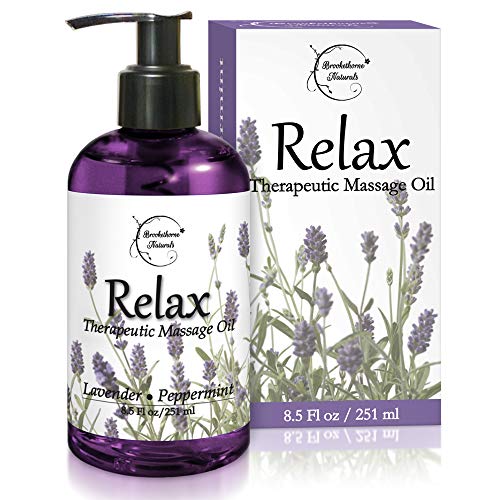Discover the transformative power of therapeutic massage! In this engaging article, we delve into the numerous health benefits of therapeutic massage, a specialized technique that goes beyond mere relaxation.
** I may earn a commission when you purchase through a link on this page. **
Unlike a standard relaxation massage, therapeutic massage targets specific health issues, promoting healing and overall well-being.

It’s not just about feeling good; it’s about fostering physical and mental health through expert techniques.
Whether you’re dealing with chronic pain, and stress, or looking to boost your immune system, therapeutic massage offers a tailored approach to address your unique needs.
Join us as we explore the remarkable advantages of this healing practice.
1. Massage relieves muscle tension and pain
Therapeutic massage relieves muscle tension and pain by relaxing the sore muscles, increasing circulation and oxygenation to the area, and releasing endorphins.
This is done by applying pressure to specific points of tension in the muscle, which helps them relax.

The increased blood flow causes nutrients to be delivered to the area and waste products to be removed more efficiently.
This helps with pain relief as well as reducing inflammation from injury or illness.
By increasing circulation and oxygenation, therapeutic massage also helps reduce swelling.
This is especially helpful for injuries that have resulted in swelling since this can lead to further tissue damage if not treated quickly enough.
2. Massage improves blood circulation
After a tough workout, your body is ready to hit recovery mode. Increased blood flow to the overworked areas speeds up recovery and promotes new muscle growth.
Therapeutic massage improves blood circulation by breaking up the layers of muscle tissue and increasing blood flow.

When muscles are relaxed, they’re able to expand more easily.
This increases their volume and allows more blood to enter the area.
This also helps reduce swelling, which is one of the causes of reduced circulation and poor blood flow.
3. Massage boosts the immune system
The immune system is a complex network of cells, tissues, and organs that work together to protect the body from infection and disease.
The immune system protects us by recognizing and destroying foreign invaders like bacteria, viruses, fungi, and parasites.

It also works to prevent cancerous cells from multiplying and spreading throughout the body.
Therapeutic massage boosts the immune system by helping to release endorphins which are natural pain relievers and also because it lowers blood pressure in the body which helps to reduce stress levels.
Massage also increases blood flow throughout your body which allows for more oxygenated blood to reach all of your organs including your brain where it stimulates mental alertness.
Also, it improves lymphatic drainage which helps to remove toxins from your body through sweating or urinating which can lead to better health overall!
4. Massage reduces stress and anxiety
Our daily lives are full of endless chores, tasks, and deadlines. From the boardroom to the living room, our lives are a whirlwind activity and we do our best to manage through it all.

Therapeutic massage can be a wonderful way to reduce stress and anxiety. It’s a great way to help you relax through the release of endorphins and other hormones, which in turn makes you feel better.
Massage also improves your circulation. This helps bring nutrients to your tissues, as well as remove toxins from them. It also reduces inflammation, which is often a root cause of pain.
Finally, massage allows you to focus on something other than the source of your stress or anxiety.
5. Massage lowers blood pressure
High blood pressure is a condition whereby the force of blood against artery walls remains consistently high. As a result, this can add pressure on the heart and blood vessels and lead to a variety of heart-related issues.
Many factors can lead to high blood pressure.

Some of these we can control or seek to improve, such as diet, stress, and lifestyle choices.
Others, however, such as age, genetics, or chronic conditions, can be more difficult to address.
Therapeutic massage reduces blood pressure by increasing heart rate and stimulating the parasympathetic nervous system.
It does this by increasing the volume of blood flowing through the veins, which causes a reduction in blood pressure.
In addition, therapeutic massage can help improve circulation by increasing capillary permeability in the skin, allowing more oxygen to be released into the surrounding tissue.
6. Massage improves sleep quality
As we age, changes in our bodies can make it more difficult to fall asleep and stay asleep. Sleeping less equals a reduction in the amount of restorative sleep we get.
If you’re not getting enough sleep, you’re not feeling your best. Joints and muscles begin to ache. In addition, your cognitive ability may also suffer.

Therapeutic massage can help relieve this pain by increasing blood flow to the affected area.
This helps increase the supply of oxygen to your tissues, which allows them to heal more quickly.
Massage also helps increase the circulation of lymphatic fluid, which helps reduce swelling and inflammation. A massage can relax the body and mind, allowing you to get the good night’s sleep you need.
7. Massage relieves headaches and migraines
Just like the effects of stress and anxiety, the impact of headaches and especially, migraines can bring your daily life to a screeching halt.
Many factors lead to the onset of these occurrences, such as stress, and tension. However, there are other contributors, like hormonal changes, dehydration, environmental factors (i.e., bright lights, noise, etc), and even some foods, that can play a factor as well.
Therapeutic massage relieves headaches and migraines by helping your blood flow more efficiently throughout your body, as well as relieving pressure on the nerves in your head.
Massage reduces stress and anxiety levels, which are often elevated when you are experiencing headaches or migraines.
This can help to relieve muscle tension and spasm and reduce inflammation that could be contributing to pain symptoms.
8. Massage alleviates symptoms of depression
Depression can cause a wide range of symptoms, including sadness, loss of interest in activities, and changes in appetite. It can also impact sleep patterns, increase fatigue, and make concentrating difficult.
Therapeutic massage helps alleviate symptoms of depression by releasing endorphins in the body.
Endorphins are part of the body’s pain-relieving system. They’re released when we exercise, for example, which helps us feel happier and more positive.
In a study published in the Journal of Alternative and Complementary Medicine, researchers found that participants who received a 30-minute massage had increased levels of endorphins in their blood and felt less depressed after the treatment.
9. Massage promotes flexibility and range of motion
Several factors can contribute to a loss of flexibility and range of motion, including decreased physical activity, inactivity and immobility, poor posture, and chronic conditions.
This underlines the importance of staying active throughout your life.
However, these factors can cause our muscles to weaken and become tight. As a result, joint mobility is reduced which leads to stiffness and muscle imbalances.
Therapeutic massage promotes flexibility and range of motion by relaxing the muscles, increasing blood flow to the areas being massaged, and breaking down scar tissue.
By breaking down scar tissue that has formed as a result of injury or surgery, massage helps with healing by relaxing and stretching muscles for increased mobility.
10. Massage improves athletic performance
Athletes are at an increased risk of developing muscle tension and pain in their muscles, tendons, and ligaments due to the repetitive motions that they perform during exercise.
This can result in muscle spasms, knots, or other injuries, which can interfere with their ability to compete or train effectively.
Therapeutic sports massage reduces these problems by relaxing overworked muscles and increasing blood flow to them, allowing them to heal faster.
FAQs
What are the main health benefits of therapeutic massage?
Therapeutic massage offers a range of benefits, including reducing muscle tension, improving blood circulation, and enhancing mental well-being. It’s particularly effective in managing chronic pain, alleviating stress, and boosting the immune system.
Can therapeutic massage help with chronic pain management?
Yes, therapeutic massage is highly effective in managing chronic pain. It works by relaxing tense muscles, increasing blood flow to affected areas, and releasing endorphins, which are natural pain relievers.
Is therapeutic massage beneficial for mental health?
Absolutely, therapeutic massage can significantly benefit mental health by reducing stress and anxiety levels. The relaxation and increased endorphin release during a massage session contribute to a sense of calm and well-being.
How does therapeutic massage improve blood circulation?
Therapeutic massage enhances blood circulation by stimulating muscle movement and relaxation. This increased blood flow helps in the efficient delivery of oxygen and nutrients to body tissues and aids in the removal of waste products.
Can therapeutic massage boost the immune system?
Yes, therapeutic massage can boost the immune system. It does so by stimulating the lymphatic system, which helps the body in fighting off infections and improving overall health and resilience.

Claudia Faucher is a full-time fitness training expert and lifestyle blogger. She is also been a certified Les Mills BodyPump instructor for the past 5 years and a fitness instructor for over 20 years. Claudia is a personal trainer and creates fitness training programs for seniors and people of all ages. She likes to use her skills and experiences to help others on their fitness journeys.
Last update on 2024-07-24 / Affiliate links / Images from Amazon Product Advertising API

